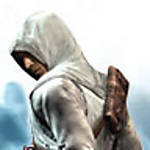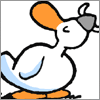M8 HMC: Step 4 Fixing of Wheels"Step 4 Fixing of Wheels" is the fourth and final chapter in the assembly of the lower hull of Tamiya's M8 Howitzer Motor Carriage. In truth "Fixing of Wheels" is somewhat of a misnomer as the chapter deals with more than merely attaching the bogey's (road wheel suspension) to the lower hull, but as seen in the below instructions also includes attaching the drive sprockets, idler wheels, engine access doors and towing pintle.
This chapter also sees me embarking upon my first serious adventures in photo-etch (PE); at this stage of the build I will also be bending and assembling the two exhaust deflector boxes as supplied in the Eduard M8 HMC Exterior PE set.
 Above are the Tamiya instructions for Step 4.
Above are the Tamiya instructions for Step 4.As can be seen from the above kit supplied instructions, most of the assembly taking place during this stage involves fitting the bogeys, idler wheels and drive sprockets as assembled in
Step 1 Construction of Wheels and
Step 2 Drive Sprocket respectively. However, as stated in the former post, as I will be painting these items separately to the vehicle, I will
not be attaching them to the lower hull during this stage. In addition, recall that I attached the track guides (the four B2 parts) to the tops of the bogeys in
Step 1 Construction of Wheels.
And so, with these sub-assemblies being excluded from this stage, all that remained for assembly were the small track roller wheels, the engine access doors, the towing pintle, and two towing eyelets.
As I am building a early-mid version of the M8 HMC, I elected to leave the towing pintle (A25) off, and so filled its locating indentation with Tamiya filler putty and sanded it smooth. The small track roller wheels (the six B12 parts) were glued to the locating lugs. As dry-fitting revealed them to fit a tad loosely, caution was exercised when gluing them into place and ensuring that they were parallel to the lower hull. The next kit part to be fitted was the engine bay access doors and overhang, represented in one piece (A20). I noted that the gaps between the doors did not extend all the way between door hinges, and so used a scribing tool complete these lines. A20 was then glued into place on the lower hull.
 Above is the lower hull tub showing the small track roller wheels fitted.
Above is the lower hull tub showing the small track roller wheels fitted.One of the more glaring mistakes on the lower hull of Tamiya's M8 HMC is the exclusion of the two exhaust deflector boxes. Fortunately Eduard comes to the rescue, and provides both the lower box and two different versions of the upper box. And thus I steeled my nerves to tackle my first serious bit of PE work.

 Above L-R: A neat trick for removing PE from the fret; and bending large pieces of PE. See text for details.
Above L-R: A neat trick for removing PE from the fret; and bending large pieces of PE. See text for details.When working with PE a far amount of caution should be practiced when both removing it from the fret and handling it. Unlike plastic, PE lost to the dreaded "carpet monster" can leave a rather nasty cut when found by a bare foot. Similarly, when handling PE parts by the edges, remember: it is fine metal and it can cut! Fortunately none of these warning are due to self-experience.
A tip I picked up on Armorama with regards to removing PE from the fret is to place a piece of masking tape on your cutting surface (for PE I use a glass surface as it does not yield to the knife resulting in a neater cut). Place the part to be removed on the masking tape and then cut down using a chisel blade. This prevents the part from shooting off and being lost on the floor or carpet ("carpet monster"). The above left picture demonstrates this.
I do not (currently) have any fancy PE bending tools, so have to make do with the basics: steel ruler; broad chisel blade; and flat long nosed pliers (i.e. no teeth). To bend a broad piece of PE, such as the deflector boxes, all I do is firmly hold down the PE under the steel ruler with the fold lines (those slight lines you see on PE) lined up with the ruler, and then gently bend, or prise, the PE up using the broad chisel blade. The above right picture demonstrates this. To bend smaller parts all I do is grip the part securely using my flat long nosed pliers, again with the "bend line" aligned to the edge of the pliers, and gently bend it (the part) again using the chisel blade.
 Above are the Eduard M8 HMC Exterior exhaust deflector box instructions.
Above are the Eduard M8 HMC Exterior exhaust deflector box instructions.The first two PE parts to be fitted were the brackets noted in the topmost cell of the above image. The two PE parts, both numbered 31, were bent at a right angle into a L-shape, and then glued (using CA glue) into place slightly above the bottommost door hinges. You may note the other items in this cell - this have been excluded until I begin work on the upper hull.
Next on the line up was the lower deflector box. Being a straight forward rectangular box (PE part 11), this was definitely the easier of the two and the better option to start more complex PE bending on. I started by folding one of the longer sides up to a right angle to what would be the back of the box, in fact if you refer to the steel ruler/PE bending image above you will see this being done. Once that had been completed, I held down the opposite side using the steel ruler and folded the back of the box to another right angle. I now had a U-shaped box. The two shorter sides were simply folded up using flat pliers, and then the edges glued using CA glue.
Having completed the basic box, I now had to insert the inner. The inner consists of four parts, a long flat piece (part 7) destined to become a U-shape and three small cross-pieces (part 33), each with a slot to meet with a corresponding slot in 7. Part 7 was shaped by first bending one side to a right angle as described above and then, due to the thin face of the backing, held down using my chisel blade and bending the part gently using pliers. Perhaps not the prettiest method, but it worked. Parts 33 were glued to part 7 and the unit slid into the box (11) and glued into place. At this point I elected not to glue the mesh grill into place as I felt that during priming and pre-shading the grill would most certainly clot. This would also present the opportunity so spray the inside of the box black before it was closed by the grill. I feel I should add that in honestly I did have a difficult time getting the box correctly placed, and was forced to remove and refit it several times. As result the box does appear slightly battered - but in my opinion given its location on the vehicle it would most likely be easily battered anyway.
Eduard provide two options for the upper deflector box, the early one piece unit and the later two-piece which appears to wrap around the towing pintle. As the towing pintle was only (factory) fitted to the last 174 vehicles (of some 1,778 odd built) and mine meant to be an early-mid model, I decided to forgo the pintle and thus the two-piece deflector. The earlier one piece deflector folds into a L-shaped box, and certainly not the easiest shape for a PE newcomer to fold. The approach to folding it requires plenty of forethought.
The lower deflector is a L-shaped box which requires the modeller to create a Z-bend - being (if you picture an L-shaped box) the top of the "foot" of the L, the front of the vertical front, and the closed-off top of the vertical. As there is also an interior to be inserted, one does not want to close the box entirely too early. So with this in mind, using the folding techniques described before and after thoroughly studying PE part 32 I set about folding the long edges. I folded all the edges to about 45 degrees first, and then with the box taking shape started gently folding these longer sides, with the exception being the front of the box (the top of the "foot" of the L and the front of the vertical front), until the sides were all at the desired angles. I then inserted the interior, consisting of the three part 23's and the long part 6, dry-fitted together into the box, and then closed the box. The reason I inserted the dry-fitted interior is because I wanted to line it up in the box before gluing it together - which is what I did once the box had been closed. The box was then glued to the plastic lower hull in the indicated position.
For the same reasons as the lower deflector box, I chose not to fit the mesh grill at this point in time. I also decided not to fit parts 32 and 45 at this time. It appears to me that these parts need to meet the upper hull, and thus I will attach them when fitting the upper to the lower hulls.
The final parts to be fitted during this stage were the pair of towing attachment points (A9) and U-shaped hooks (A6). These were glued into place and the slightly raised edges sanded smooth.

 Above L-R: A view of the rear showing the fitted deflectors; and a right-rear view showing the completed stage.
Above L-R: A view of the rear showing the fitted deflectors; and a right-rear view showing the completed stage.The next chapter, Step 5 Turret 1, is one of the longer chapters featuring the construction of the left and right sides of the turret - with
many PE additions.









) and...?


































 Eduard and Aber both kindly post .pdf copies of the kit instructions on their sites. It certainly does help before spending the dosh.
Eduard and Aber both kindly post .pdf copies of the kit instructions on their sites. It certainly does help before spending the dosh.  I was attempting to link to the product page on the Eduard site for you, but I can't seem to connect at the moment.
I was attempting to link to the product page on the Eduard site for you, but I can't seem to connect at the moment.


 I was looking at that and figured I'd best say something. However, I don't think you may be able to move it back further.
I was looking at that and figured I'd best say something. However, I don't think you may be able to move it back further. 











 I think only the top rear edge of the deflector should be glued to A20, with the top of the foot of the "L" lining up with the cut-out (for lack of a better word which escape me right now) corners of the hull. The sides of the deflector have two small bits which protrude to the rear - I'm guessing the deflector rests these against the engine access doors.
I think only the top rear edge of the deflector should be glued to A20, with the top of the foot of the "L" lining up with the cut-out (for lack of a better word which escape me right now) corners of the hull. The sides of the deflector have two small bits which protrude to the rear - I'm guessing the deflector rests these against the engine access doors. 









 I'm sorry all that work was almost for not.
I'm sorry all that work was almost for not. 




































 .
.



















 )
) 


 I'll be fixing this in the text, so future readers may not see this slip-up. Am I correct in my estimation of how the upper deflector should fit?
I'll be fixing this in the text, so future readers may not see this slip-up. Am I correct in my estimation of how the upper deflector should fit?
 Shame on you and Noofesh for not knowing Calvin & Hobbes - it should be required reading for all youth!
Shame on you and Noofesh for not knowing Calvin & Hobbes - it should be required reading for all youth!
 I'm utterly shocked by the youth of today! Don't know C&H... what next? Don't know Dilbert?!?
I'm utterly shocked by the youth of today! Don't know C&H... what next? Don't know Dilbert?!?  Spare time? What's that? LOL!
Spare time? What's that? LOL! 


 Hope they did.
Hope they did. 




